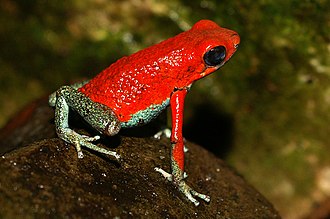

Aposematism is the advertising by an animal, whether terrestrial or marine, to potential predators that it is not worth attacking or eating.[1] This unprofitability may consist of any defenses which make the prey difficult to kill and eat, such as toxicity, venom, foul taste or smell, sharp spines, or aggressive nature. These advertising signals may take the form of conspicuous coloration, sounds, odours,[2] or other perceivable characteristics. Aposematic signals are beneficial for both predator and prey, since both avoid potential harm.
The term was coined in 1877 by Edward Bagnall Poulton[3][4] for Alfred Russel Wallace's concept of warning coloration.[5] Aposematism is exploited in Müllerian mimicry, where species with strong defences evolve to resemble one another. By mimicking similarly coloured species, the warning signal to predators is shared, causing them to learn more quickly at less of a cost.
A genuine aposematic signal that a species actually possesses chemical or physical defences is not the only way to deter predators. In Batesian mimicry, a mimicking species resembles an aposematic model closely enough to share the protection, while many species have bluffing deimatic displays which may startle a predator long enough to enable an otherwise undefended prey to escape.
- ^ Santos, J. C.; Coloma, Luis A.; Cannatella, D. C. (2003). "Multiple, recurring origins of aposematism and diet specialization in poison frogs". Proceedings of the National Academy of Sciences. 100 (22): 12792–12797. doi:10.1073/pnas.2133521100. PMC 240697. PMID 14555763.
- ^ Eisner, T.; Grant, R. P. (1981). "Toxicity, Odor Aversion, and 'Olfactory Aposematism'". Science. 213 (4506): 476. Bibcode:1981Sci...213..476E. doi:10.1126/science.7244647. PMID 7244647.
- ^ Poulton 1890, pp. Foldout "The Colours of Animals Classified According to Their Uses", after page 339.
- ^ Cite error: The named reference
Marekwas invoked but never defined (see the help page). - ^ Cite error: The named reference
Wallace 1877was invoked but never defined (see the help page).